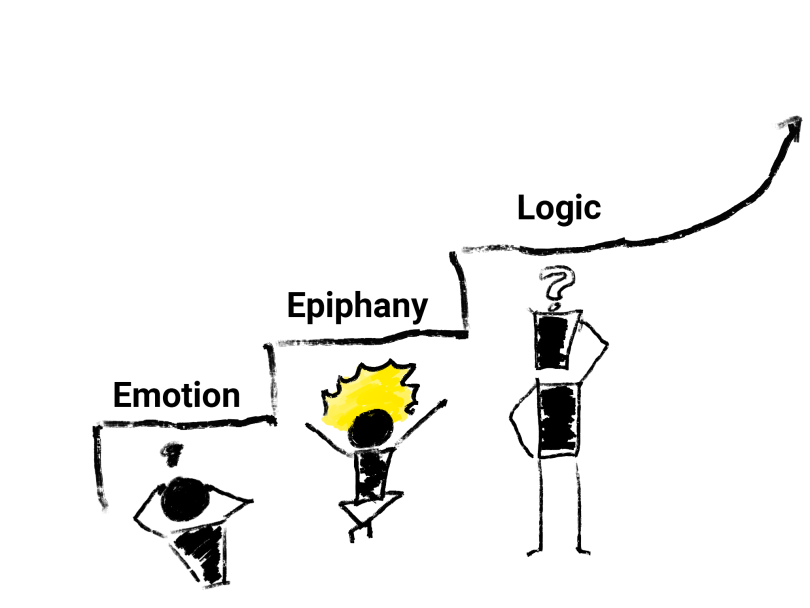Introduction
Let’s say you’re in a simulation. You’ve reached the end.. Let’s say it’s the bad ending. which of these is better?
Which of these works better for stories in learning?
Situating Interactive Stories
As I mentioned in a previous post, I am currently participating in a group concentrating on writing interactive stories. And the particular niche that we define for interactive stories in the learning space is that they live in the space of acting as a catalyst. They take “cold” learners — learners that don’t care or don’t see what you’re trying to teach is important — and turn them into “hot” learners: learners that are highly motivated to learn because they believe that this issue is important and they want to do something.
And that matters because, in thinking about what works better in learning, we need to think about where the product is situated in the learning journey.

So, we’re talking about interactive stories, situated as catalysts to the learning journey. And one of the questions I had was
Why are we focusing on third person points of view when it seems like lots of gameful experiences focus on first person points of view?
First and Third Person
What do we mean about first and third person?
A Quick Note
If you took a look at the above definitions and the first interactive, you’re probably saying,
“Just so ya know, Kristin, you actually demonstrated second person, not first person.”
You are so, so right. That said, I think that while we write in the second person in terms of interactive fiction/stories, the most fundamental idea is that the player/reader/learner in that case is thinking about the choices “I” made, or what “I” did. So, I think it’s a bit helpful to think about it in terms of first-person from an immersion standpoint. However, we would actually be writing in the second person.
Now… on with the post.
As a casual gamer, I find myself surprised in thinking about writing this kind of interactive story, something for learning, and not positioning it in the first person POV. What about that sense of immersion? Shouldn’t that be part of our goal?
Well… Maybe not.
[Note, I don’t have any kind of research to back this up, but if anyone can point to some for or against, I’d love to hear about them.]
The main argument that we talked about in my group was that third person works well in these kinds of catalyst stories because they allow learners to explore a theme, perhaps especially a difficult theme, without coming up against their own ego and sense of self.
Instead of feeling defensive (“No, I didn’t fail to get the job!”), the learner is able to develop a relationship with this character, see themselves in that person, and through their choices (remember we’re making an interactive story) try out things that reflect their own situation without feeling like a failure.
This idea resonated with me, first because it was a little surprising and also because I had approached the idea a couple of months previously in a professional development group at work where someone presented a simulation/interactive fiction case study in a course.
It also brought me back to something I’ve been thinking about since my undergraduate days(that’s quite a while ago) . Probably my favorite TV show of all time is the Twilight Zone and one of the reason I think it continues to stand the test of time, in spite of it’s very 1960s special effects is that it is, at it’s core, an anthology series exploring what it means to be human at our very best and at our very worst. And through the veil of science fiction and fantasy, it asks us to consider issues like racism.
Star Trek, I understand, also has a long history of doing similar things. That distance of fiction and other is what can allow their audiences to confront things they may be uncomfortable with.
But What about all that First Person stuff?
One of the other things I liked about what I’ve learned was the idea that, again, this interactive story is positioned as a catalyst. But once that learner is in the “hot,” highly motivated state, then you can hit them with that first-person immersive simulation because, at that point, they’re ready to put themselves in that seat.
Next Steps for Exploration
So what do you do with that? For myself, I’m dedicating time to working at writing and publishing interactive stories. I really think that this is a niche that I’d like to find my own voice in for the long term as a learning experience designer and I’m trying to work that out by doing the work and see what happens.
What are your thoughts on first vs third person in interactive stories in learning?
What the Heck was This?
Welp. this was my attempt at an explorable explanation. Nicky Case is one of my creative heroes and, in the spirit of storytelling, I thought I’d give this a try. It took a really long time to make this post, but it was an interesting exercise.